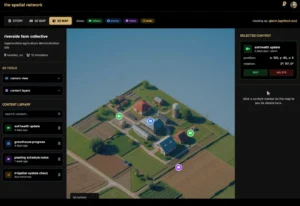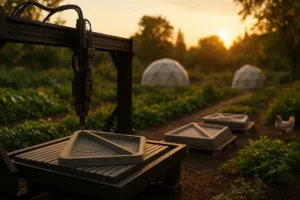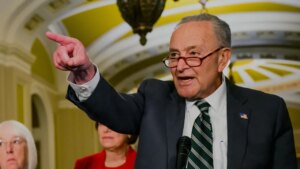As part of our “Inspiring Successful Stories” series, we sat down with visionary entrepreneur and regenerative futurist Mayan Metzler to explore the ideas behind The Spatial Network. This groundbreaking geospatial platform reimagines how we build, connect, and collaborate in a rapidly evolving world. With deep roots in land-based innovation and a mind wired for systems thinking, Mayan isn’t just thinking about the next big thing — he’s designing the digital and physical infrastructure that communities will soon rely on. In this conversation, we’ll discuss maps, AI, domes, decentralized governance, and what it truly takes to turn a vision into a global movement.
Galt’s Landing offers a vision of community thriving together in relationship with the land.
Why did you feel it was necessary to build a ‘spatial’ network?
While many social platforms revolve around scrolling feeds of photos or videos, it didn’t reflect how people live or build things in the real world. Life is spatial; we live in a three-dimensional world and relate to one another through handshakes and maps. That’s why we believe geospatial management is key. Currently, with significant shifts in the economy, technology, and the environment, land-based projects have never been more crucial. The people leading these efforts often operate from a deep sense of purpose and passion, but that doesn’t always mean they have the right tools to organize, scale, or secure backing.
So we built something to support them. A tool that not only helps manage what they’re already doing, but also lets them visualize and communicate what’s possible. It’s like giving them a sandbox where they can SHOW the future they envision and invite others to help make it real.
What kind of users do you imagine joining the network?
We envision a diverse range of users joining the Spatial Network, from heart-led, environmentally conscious communities and regenerative land projects to urban planners looking for innovative ways to visualize sustainable development. We also see content creators, influencers, and businesses discovering new opportunities to make their offerings relevant through geospatial mapping, ultimately creating a truly global and dynamic community.
How are you contributing to the current AI boom?
We’re deeply engaged with the latest advancements in AI, constantly testing models from leading projects like Anthropic, Google, and OpenAI. We’re also creating our specialized language model that enhances the ecosystem by connecting bioregional insights with individual project goals, fostering collaboration among local economies. Additionally, we’re making AI more accessible by encouraging users to request custom AI agents tailored to their needs, which we then integrate into our AI marketplace, making advanced tools available to everyone. Perhaps the most significant contribution we are making is proving a use case for AI, as it directly correlates to the environment. We are creating bioregional reports, connecting our LLM to local agricultural information, and testing how these land-based projects can leverage AI, which is a critical aspect of the ‘Internet of Things’. We feel this is a meaningful contribution to the current AI boom.
What kind of team is needed to develop such a new ‘tool of the age’?
Our team is a dynamic blend of visionary executives who network globally and form strategic partnerships. We also have a robust team of developers, including skilled cartographers and AI researchers. As we’re focusing on land-based projects, we have an architect on the team to oversee the built aspects of our developments. Managing eight properties around the world, it’s also essential that we have wellness practitioners and hosts who bring these experiences to life in our retreat centers. On the creative side, we have storytellers who explore innovative ways to utilize geospatial content in social media and community engagement. Our partnership with HomeLink is also an extension of our team into smart home tech, and Dr. Lana Morrow brings expertise in personalized wellness care at home through Think Interfaces.

Engineering and refinement of modular ecostructures with TerraLux domes.
Are there industries beyond regenerative farming that can benefit from this tool?
Absolutely! Beyond regenerative farming, our map-making tools are valuable for a wide range of industries and individuals. For example, franchised brands can use maps to showcase their locations and provide customers with access to catalogs, as German Kitchen Center is doing with their showrooms. Modern adventurers can document their journeys, sharing photos and stories from their explorations. Culinary critics can create maps of all the restaurants they’ve reviewed, complete with pictures and videos of their meals. Additionally, map-making can become a new form of content for influencers, such as skateboarders who can map out their favorite skate spots, share videos of their tricks, and invite their community to do the same.
What are some examples of current projects that TSN is adding to the map, highlighting its function and potential?
One standout example of TSN’s potential is the project with Jim Gale and Galt’s Landing. Galt’s Landing is a regenerative demonstration site in Central Florida, showcasing sustainable practices like permaculture, composting, and community engagement. By utilizing TSN’s tools, Galt’s Landing can map out and share its regenerative journey, providing a digital twin of the site that facilitates the coordination and visualization of regenerative projects on a global scale. This collaboration highlights how TSN can bring visibility and connectivity to innovative, land-based initiatives.

The Spatial Network’s 3D mapping system with geospatial content.
As a Regenerative Futurist, where do you see society and the economy going over the coming decades?
I believe we’re moving toward a circular economy model, and this shift will impact everything — from how we manufacture goods to how we behave in our community and our relationships with the land.
There are six key technologies I see playing a significant role in supporting that transition:
First, IoT — the Internet of Things. It enables us to connect physical spaces with digital intelligence, gather real-time data from sensors on the land, and make more informed and responsive decisions.
Second, AI. We’re entering a new era of simulation, systems insight, and task automation that goes far beyond what humans alone can manage.
Third, peer-to-peer infrastructure. This will give local communities more agency, enabling people to collaborate, trade, and coordinate from the ground up, rather than waiting on centralized systems.
Fourth is edge computing. It’s not often discussed, but it’s essential — letting local machines handle localized tasks without requiring a constant connection to the cloud, which improves speed, sovereignty, and relevance.
Fifth is 3D printing. Local fabrication will play a significant role in the new economy, where people can receive digital files and manufacture components themselves, thereby reducing their dependency on long supply chains. We’re already integrating this with our dome-building approach.
And finally, Web3. On-chain systems provide us with tools for genuine ownership and authentication. This enables buyers to establish a personal connection with real-world assets. From a logistics perspective, it allows the tracking of deliveries through the supply chain, from the point of origin to the final destination.
All of these together help us shift from extraction and centralization to regeneration and localization. That’s the direction I see the future moving.
Why do you think TSN is particularly relevant to America right now?
The Spatial Network is particularly relevant to the United States right now due to the growing need for self-reliance and local resilience, especially in an uncertain global landscape. Initiatives like “Make America Healthy Again” underscore a collective desire to reconnect with nature and enhance overall well-being. TSN supports this by fostering local connections, empowering communities to trade and collaborate, and bringing real-world relevance to digital tools. This ultimately helps innovative local projects gain visibility and thrive, strengthening local economies, manufacturing, and agriculture.
What other areas of human innovation and evolutionary advancement does TSN complement and integrate with?
The Spatial Network aligns closely with advancements in wellness technologies, promoting the idea of creating homes that contribute to healing and overall well-being. By encouraging personalized health care through in-home devices that provide biofeedback and facilitate various treatments, TSN is helping to bring futuristic concepts into our daily lives. This integration of personalized wellness technology at home, in collaboration with experts like Dr. Lana Morrow, represents a natural extension of TSN’s mission to reconnect people with their environment and enhance quality of life. This is where all of the talk about “AI” and “Smart Tech” takes on personal relevance, and I genuinely feel this is where we will gain mass adoption. Our family’s health will spur our collective evolution.

3D printing on-site reduces transport costs and empowers local manufacture.
If people wish to join TSN, what invitation do you extend? What is the call to action?
Now is the perfect time to join The Spatial Network, as we have a working beta with our first users already on board. We’re offering early adopters a unique, personalized experience with dedicated attention from our team, ensuring that their feedback directly shapes our development. If you’re a community builder or someone leading a land-based project, we encourage you to reach out and get started right away! Find out more at https://thespatialnetwork.net/shares.
In Closing:
What Mayan Metzler and The Spatial Network represent isn’t just another leap in digital innovation; it’s a return to grounded, community-rooted intelligence. As we face a future where connection and collaboration are more essential than ever, tools like TSN are not only welcome, they’re vital. Whether you’re a land steward, a futurist, or simply someone curious about what comes next, this is your invitation to step into the map and help redraw the way we live, build, and belong.

Mayan Metzler, the visionary CEO
Finally, what’s the best way for our readers to stay informed about this exciting new development?
For anyone interested in staying connected or learning more, we invite you to visit our websites at TerraLux and our Facebook page. If you’d like to discuss this directly, please email us at –mayan@GermanKitchenCenter.comor call us at (347) 992–0410.
The Press Release The Spatial Network: Mayan Metzler’s Blueprint for a Grounded, Geospatially-Aware Future—With Marco Derhy appeared first on Pinion Newswire.





